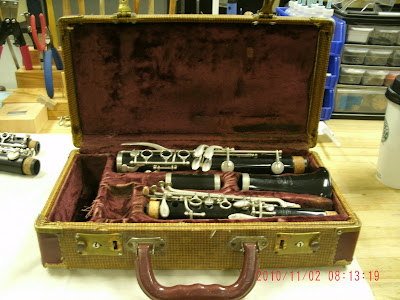My project clarinet is an Aristocrat model by the Buescher Company. The serial number dates this clarinet to a much later date than the trumpet I previously worked on but it is still excellent practice, providing hands on experience with different instruments.
The first step is to start disassembling and cleaning. Here you can see some of the dirt and grime that I was up against.
This photograph was taken after removing all of the corks and the pads from the keys. The next step is to remove the tenon corks and head to the chem room for cleaning.

 Here you can see everything cleaned up. The clarinet was scrubbed in Simple Green and the keys were soaked in phosphoric acid. Now it is time to start key fitting. I found a lot of lateral play and end play in most of the keys. This clarinet has pilot pivot screws which made the job a little more frustrating but I am happy with the results.
Here you can see everything cleaned up. The clarinet was scrubbed in Simple Green and the keys were soaked in phosphoric acid. Now it is time to start key fitting. I found a lot of lateral play and end play in most of the keys. This clarinet has pilot pivot screws which made the job a little more frustrating but I am happy with the results. 
Several of the posts were stripped so in order to remedy the situation I made new hinge rods. The Bundy Company uses a custom size for their screw threads that does not match the standard sizes available. It is in between a #0 and #1 size screw. I was able to use stock hinge rod at .077" for the new rods. I used a 1-56 die to create new threads which allowed the new hinge rod to fit into the post without having to tap them larger. Here you can see the old rod on the the left next to the new one on the right.

After I was certain that they keys were all fitting properly I buffed them so that they would be ready for new pads and corks.
 The bell tenon on this clarinet is both cracked and chipped. I used super glue to fill the crack and then wrapped the tenon in unwaxed dental floss in order to hold it together. The tenon needs to be replaced completely but that will have to wait until next semester. This is the reason for the loose wrapping of the dental floss. It is only a temporary fix in order to provide strength until the tenon can be properly replaced.
The bell tenon on this clarinet is both cracked and chipped. I used super glue to fill the crack and then wrapped the tenon in unwaxed dental floss in order to hold it together. The tenon needs to be replaced completely but that will have to wait until next semester. This is the reason for the loose wrapping of the dental floss. It is only a temporary fix in order to provide strength until the tenon can be properly replaced. I chose to use a cork pad for the register key. Cork is often the preferred choice for padding in the upper joint of the clarinet and is a very durable option for a padding material. Using cork for the entire upper joint would have been an expensive option for this clarinet so I decided just to do the register key for some practice.
I learned a useful trick while corking the low Ab/Eb key. This clarinet has a small post designed to stop the key from contacting the body. The problem is that the point of contact between the post and underside of the touchpiece is very small. This causes the cork to wear and be replaced much to fast. There are alternatives to natural cork but the large touchpiece makes the cork extremely visible. Here you can see a creative solution to this problem. A hole is cut in the natural cork and plugged with a small piece of
Gummi Cork which does not look as attractive but is far more durable.
I used this technique on the throat Ab key as well but also made a correction to the post because of the dramatic angle at which it contacted the key. Notice the sharp point on the post in the first picture. This causes unnecessary fatigue and replacement of almost any material available. It was a quick modification that should help the longevity of this repair. I simply ground a new angle into the top of the post without even having to remove it from the body. Now there is a much larger area of contact which translates into less stress on the materials.
After all of the padding and corking were complete it was time for a play test and then a final polishing. Here you can see the completed clarinet ready for the customer, but hopefully it will stick around the shop long enough for me to replace that chipped tenon.










